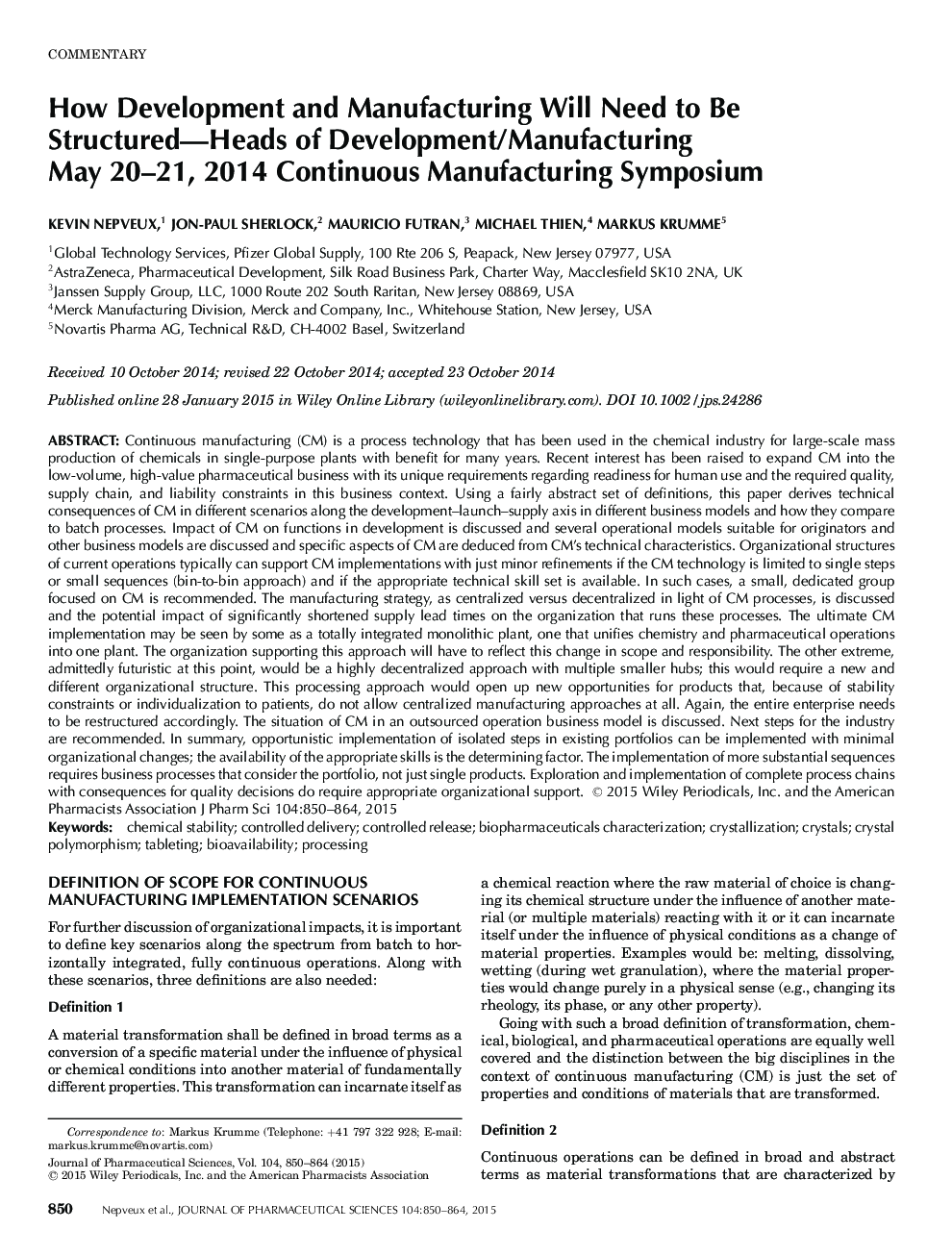| کد مقاله | کد نشریه | سال انتشار | مقاله انگلیسی | نسخه تمام متن |
|---|---|---|---|---|
| 10162048 | 1114315 | 2015 | 15 صفحه PDF | دانلود رایگان |
عنوان انگلیسی مقاله ISI
How Development and Manufacturing Will Need to Be Structured-Heads of Development/Manufacturing May 20-21, 2014 Continuous Manufacturing Symposium
دانلود مقاله + سفارش ترجمه
دانلود مقاله ISI انگلیسی
رایگان برای ایرانیان
کلمات کلیدی
Controlled release - انتشار کنترل شدهCrystallization - بلورسازیControlled delivery - تحویل کنترل شدهbiopharmaceuticals characterization - خصوصیات بیوفارمینتیکProcessing - در حال پردازشBioavailability - فراهم زیستیTableting - قرصChemical stability - پایداری شیمیاییCrystal polymorphism - پلی مورفیسم کریستالCrystals - کریستال ها
موضوعات مرتبط
علوم پزشکی و سلامت
داروسازی، سم شناسی و علوم دارویی
اکتشاف دارویی
پیش نمایش صفحه اول مقاله

چکیده انگلیسی
Continuous manufacturing (CM) is a process technology that has been used in the chemical industry for large-scale mass production of chemicals in single-purpose plants with benefit for many years. Recent interest has been raised to expand CM into the low-volume, high-value pharmaceutical business with its unique requirements regarding readiness for human use and the required quality, supply chain, and liability constraints in this business context. Using a fairly abstract set of definitions, this paper derives technical consequences of CM in different scenarios along the development-launch-supply axis in different business models and how they compare to batch processes. Impact of CM on functions in development is discussed and several operational models suitable for originators and other business models are discussed and specific aspects of CM are deduced from CM's technical characteristics. Organizational structures of current operations typically can support CM implementations with just minor refinements if the CM technology is limited to single steps or small sequences (bin-to-bin approach) and if the appropriate technical skill set is available. In such cases, a small, dedicated group focused on CM is recommended. The manufacturing strategy, as centralized versus decentralized in light of CM processes, is discussed and the potential impact of significantly shortened supply lead times on the organization that runs these processes. The ultimate CM implementation may be seen by some as a totally integrated monolithic plant, one that unifies chemistry and pharmaceutical operations into one plant. The organization supporting this approach will have to reflect this change in scope and responsibility. The other extreme, admittedly futuristic at this point, would be a highly decentralized approach with multiple smaller hubs; this would require a new and different organizational structure. This processing approach would open up new opportunities for products that, because of stability constraints or individualization to patients, do not allow centralized manufacturing approaches at all. Again, the entire enterprise needs to be restructured accordingly. The situation of CM in an outsourced operation business model is discussed. Next steps for the industry are recommended. In summary, opportunistic implementation of isolated steps in existing portfolios can be implemented with minimal organizational changes; the availability of the appropriate skills is the determining factor. The implementation of more substantial sequences requires business processes that consider the portfolio, not just single products. Exploration and implementation of complete process chains with consequences for quality decisions do require appropriate organizational support. © 2015 Wiley Periodicals, Inc. and the American Pharmacists Association.
ناشر
Database: Elsevier - ScienceDirect (ساینس دایرکت)
Journal: Journal of Pharmaceutical Sciences - Volume 104, Issue 3, March 2015, Pages 850-864
Journal: Journal of Pharmaceutical Sciences - Volume 104, Issue 3, March 2015, Pages 850-864
نویسندگان
Kevin Nepveux, Jon-Paul Sherlock, Mauricio Futran, Michael Thien, Markus Krumme,